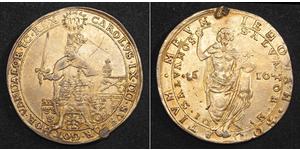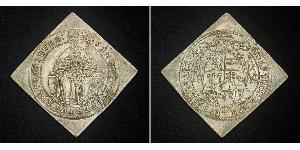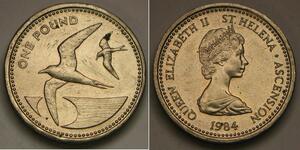(sold for $134.0)
1652, Salzburg, Count Paris von Lodron. Scarce Silver 1/4 Thaler Klippe Coin.
Mint Year: 1642
Mint Place: Salzburg
Ruler: Count Paris von Lodron.
Reference: Proksch 1275, KM-103.
Denomination: Quarter Thaler Klippe
Condition: Tiny mounting mark, otherwise a nice VF+
Diameter: 43mm
Material: Silver
Weight: 7.10gm
Obverse: Madonna with Child and staff. Count Paris von Lodron´s arms (Lion), topped by cross under papal Legae's hat below.
Outer Legend: + SPS : SALI : SE : AP : L . PARIS . D:G : ARCHI +
Inner Legend: SIDIVM . CONF VG: SVB . TWM . PRA
Obverse: Saint Rupert, wearing episcopal regalia, holding crozier and salt barrel. Value (1/4) above arms of Salzburg below.
Legend: SANCT . RVDBERTVS - EPS . SALISBVRG : 1642
Saint Rupert, Salzburg’s patron saint, is featured on many coins issued by the city’s ecclesiastical rulers. Salzburg was built on the site of an ancient Celtic (and later, Roman) settlement. Rupert is believed to have founded the modern town around 700. He is commonly depicted holding a saltcellar, symbolic of the city’s valuable salt mines, which inspired the city’s modern name.
The Archbishopric of Salzburg was an ecclesiastical state of the Holy Roman Empire, roughly consisting of the present-day state of Salzburg (the ancient Roman city of Iuvavum) in Austria.
Since 1648, the Archbishop of Salzburg has also borne the title Primas Germaniae ("First [Bishop] of Germania"). The powers of this title – now non-jurisdictional – are limited to being the Pope's first correspondent in the German-speaking world, but used to include the right to summon the Prince-electors. The Archbishop also has the title of legatus natus ("permanent legate") to the Pope, which, although not a cardinal, gives the Archbishop the privilege of wearing a cardinal's scarlet vesture, even in Rome.
In the Holy Roman Empire, the Thaler was used as the standard against which the various states' currencies could be valued.
The Italian-Tyrolean Count Paris von Lodron (1619 to 1653) managed, thanks to his diplomatic talents, to keep Salzburg Land largely intact throughout the Thirty-Years War. The new university of Salzburg was also inaugurated in this period, and named after him.

|
Posted by:
anonymous 2014-01-29 |
1 Pound Ascension Island / Saint Helena (1981 - ) Silver Eli ...
group has 5 coins / 2 prices
⇑
















-300-150-KtDBwcI0XgEAAAEoWKP7lK.O.jpg)







